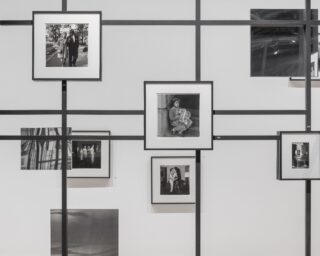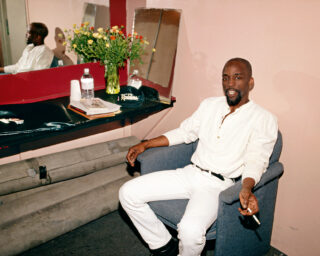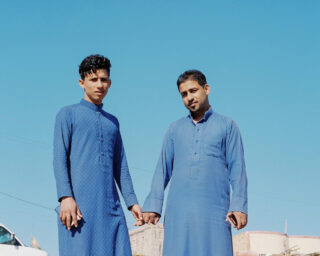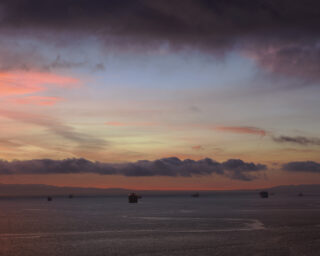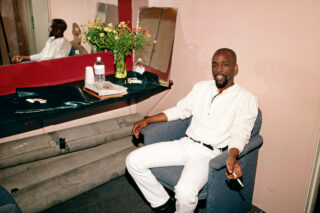Chirodeep Chaudhuri – A Village in Bengal
Chirodeep Chaudhuri’s exhibition A Village in Bengal is on view at Project 88, Mumbai, until March 25.
This exhibition of twenty-two black-and-white photographs samples the images included in Chirodeep Chaudhuri’s recent book A Village in Bengal, which records life in Amadpur, his parents’ ancestral village in the northeast Indian state of West Bengal, where he spent holidays as a child. Travelling to Amadpur annually over twelve years, Chaudhuri has captured the town’s life thoroughly and unsentimentally. His intense gaze takes in many inhabitants, animals, and architectural details: there is a decrepit terra-cotta temple; ducks crossing an unpaved road, single file, like the Beatles on the cover of Abbey Road; a bull at rest, his expressive shadow merging with that of the shade he’s sought; and a throng of women standing before an elegant landowner’s villa. This range of imagery could very well describe rural settings elsewhere in India. Yet Chaudhuri’s ability to capture gestures, architecture, and landscape distils these scenes of a symbolic home into a coherent, singular narrative which treats the photographer’s stated intention—“to see, store, and air again the unutterably fragile experience of home.” A Village in Bengal is a serious exploration of memory and uncertain recollection, filtered through the vivid panorama of the annual festival of Durga Pujo.
Durga Pujo is an autumnal fête celebrating a principal female Hindu deity of destruction. To adherents and outsiders alike, Pujo, as the festival is sometimes called, is emblematic of Hindu Bengali identity. Many view this vibrant five-day event as the religious counterpart to the Bengali discursiveness that suffuses daily life, from fiery polemical discussions and a passion for the arts to political zeal and culinary profligacy. To his credit, Chaudhuri’s record of the kaleidoscopic activities around Durga Pujo stays this expectation. The show does not replicate the flamboyance traditionally associated with Durga Pujo by mechanically archiving exemplary moments. Rather, he has created a narrative complicated by silent passages about Amadpur that relate only metonymically to the festival. The resulting photo-essay is forcefully ordinary yet persuasively structured by combining precise details and necessary distance. It is here one begins to understand how a personal album can also function, as the photographer suggests, as a historical chronicle of “traces of a lifestyle that once existed.”

Chirodeep Chaudhuri, Untitled–18, 2012, from the series A Village in Bengal. Courtesy of the artist and Project 88, Mumbai.
The album-like quality of this series has an obvious derivation: the subjects include the photographer’s distant relatives in their palatial ancestral home in Amadpur. Untitled-18 depicts a group of women headed by one man assembled at a dining table topped with plates of food, possibly the ingredients of festival cuisine, and a boy of about two or three years old. The scene has all the traits of a conference at an impasse or at its end. Several of the figures cover their mouths with their hands; speech is absent; body language is static, detached. The torpor of the situation is strongly conveyed by the proximity of the camera. Ironically, this intimate stock-taking effectively lends the image the character of a political event, as though it were documented by an official recorder granted security clearance. Seen another way, however, the image also conveys the boredom of a certain kind of gaze, that of a child uninterested in a group of adults engaged in boring adult things—here literalized by the child’s listless body near the center of the composition, possibly a proxy for the photographer in his early years.
Likewise, Untitled-22, perhaps the best image in the show, is also a visual argument about the fickle nature of photographic meaning. In this case an archetypal episode drawn from the Pujo rituals offers a window onto people’s changing relationships to religious customs. The photograph features the multi-armed Durga at the moment of her immersion, the definitive endpoint of the festival. The camera is positioned above a body of water to show a group of boys who are thrusting a large, Ferris wheel–shaped contraption into its depths. The wheel-shaped contraption is the rear frame of a three-part Durga idol structure. Durga and the flanking idols are naked, as if disrobed in preparation for their watery commute. Surprisingly, they are missing their heads. The image is charged with movement and a romantic excess of luminosity. This arguably timeless scene of play and happiness might also represent what Pujo means to a band of frolicking boys at any moment in Bengali history. But key aspects of the scene caution against facile judgement, beginning with the headless, naked idols, whose schematic bodies, minus the ritual clothing, are less sexual than campy.In contrast, the half-naked boys are emphatically sensual. Caught between the sterile idols and our living gaze, they signal a palpably cinematic sensibility of compressed time: psychologically anachronistic frames joined into a one-shot face-off. It is as if Chaudhuri’s childhood self can recall not how fun looked but felt, which his adult photographer’s eye has stolen of innocence.

Chirodeep Chaudhuri, Untitled–22, 2012, from the series A Village in Bengal. Courtesy of the artist and Project 88, Mumbai.
Two other images explore the show’s central theme: how perception shifts in recollection. Untitled–11 (2012) is a twelve-by-eighteen-inch image of a man floating, belly-up, in a pond. His face is clear while the rest of his body is obscured by cloudy water. The play between clarity and ambiguity is obvious, as is the perceptual uncertainty of apprehending a physical body in an inherently murky medium; here the pond could easily stand in for the dark well of the past. In Untitled–14 (2012), a wiry set of hands are depicting quilting a bedspread. The hands’ shadows mask the needle and throw in doubt whether the act of sewing is taking place. After all, the bedspread is only minimally worked. At left in the foreground is a safety razor, and to the right a pair of glasses, which emphasize yet again the mental processes of editing and refraction that impact how memories form.
Prajna Desai is a writer of fiction and nonfiction, and an academic editor. She teaches architectural history in Mumbai, which is currently her home.












